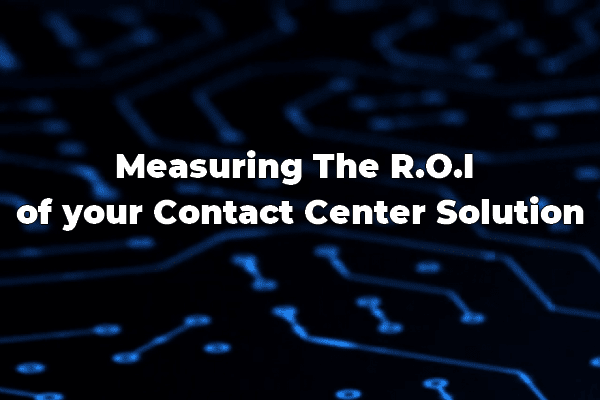Running a successful contact center means you’re responsible for keeping customers happy and your agents performing effectively so that your company may thrive. And generating an ROI on your contact center to increase your company’s bottom line is part of that growth strategy.
You are aware that technology will be critical in 2022 and beyond for the industry. And that without a good review of your contact center technology, your company will not be able to grow. But how much does your technology add to your company’s revenue?
In this article, we’ll show you how to calculate the ROI of your contact center system and analyze your investment, costs, as well as how to choose a technology provider.
How to determine the ROI for a Contact Center Solution?
 ROI (Return on investment) measures the return on a future, past or current investment over a given period. In other words, it makes it possible to calculate the return on investment by taking into account the money invested, and the money earned or lost. This is why, among other things, it is intended to guide the choices of call centers in terms of investments.
ROI (Return on investment) measures the return on a future, past or current investment over a given period. In other words, it makes it possible to calculate the return on investment by taking into account the money invested, and the money earned or lost. This is why, among other things, it is intended to guide the choices of call centers in terms of investments.
In terms of numbers, ROI is expressed as a percentage. It is calculated as follows:
Percentage of ROI call centers = (Total Income – Total Expenses)/Total Cost of Investment] x 100
For example, for an investment of $10,000, if it yields 15,000 dollars, then the ROI is 50% ((15,000 – 10,000)/10,000 = 50)
Easy right? Actually, no, it’s not that simple!
When it comes to contact centers software, it is quite difficult to evaluate the gain or return directly related to the use of such technology, in a purely quantitative way. However, what you need to master and know in the formula is the total cost investment.
How to determine the ROI for a Contact Center Solution? The process!
1. Do an in-depth analysis on your current contact center operations
Don’t jump in to purchase just yet. Dig deep and do an in-depth analysis of the current processes and compare them with what a contact center solution would offer.
How many manual steps will the solution eliminate?
What do current processes look like?
You might also be surprised by the amount of tasks your current contact center solution automates for you. There is no limit to how automation could be helpful, especially when you factor in metrics like agent efficiency and cross-selling.
2. Ask the provider the right questions
If the contact center solution provider is willing to provide detailed benchmark information, see what they include. Review this with your team to determine how the solution compares to other options.
Here are some of the questions you should to ask:
- What kind of process are you providing to support agents?
- How many steps do agents have to do to process a customer?
- How is each step prioritized? What would be the optimal order to perform the steps?
- Would the solution benefit from a unified CRM?
- How often do agents need to call or e-mail the solution to complete a task?
- What is the average amount of time each step takes?
- Are there pre-defined rules and sequences that can optimize the steps to the desired output?
- What kind of flexibility do you offer the agent?
- How do you plan to measure the customer service process?
- What analytics do you offer?
- What is the expected ROI?
3. Get to know your contact center agents, managers, supervisors and implementation teams’ needs
You don’t want to sign up for a contact center solution simply because of the claim it will improve your contact center KPIs. Instead, meet with the sales and implementation teams to see how they will be able to deliver and track the project and how much it will cost you.
4. Determine what your contact center requirements are
Have you identified all the implementation requirements of the contact center solution? ( Hardware, IT, Migration etc.) And how can those requirements impact the cost and effectiveness of the solution?
And there are 2 types of requirements:
Hardware:
- CPU: Intel Core i3
- 4GB RAM available
- 10/100 Network interface
- Color monitor, minimum resolution 1024×768 px
- Mouse or a trackpad (mouse recommended for efficiency)
- USB DSP Noise-cancelling headset. We recommend: Plantronics Audio 400 DSP USB or better.
Software:
- Modern web browser (latest version of Chrome recommended)
5. Re-evaluate your current process
Don’t just sign up for a contact center solution and call it a day. Instead, ask your team to review your current contact center process and determine if it is aligned to your ideal requirements.
What would a better process look like? What is required to accomplish those results? It will be easier to determine if the right solution is available for your business with these criteria.
Many contact center personnel have heard of the omnichannel strategy and have a basic idea of what it entails in practice. Few, however, are those who, in the context of a contact center, have a clear understanding of how to monetize the omnichannel business model.
 “Companies are not succesful at Omnichannel because they use different tools from different owners, who have their own goals.” Jason Cutter, CEO of Cutter Consulting Group.
“Companies are not succesful at Omnichannel because they use different tools from different owners, who have their own goals.” Jason Cutter, CEO of Cutter Consulting Group.
Check our webinar session for contact center decision-makers who are exploring the implementation of omnichannel technology in their organizations. During this session, we will examine what it takes to build an omnichannel solution and how it may assist contact centers in expanding their reach beyond their traditional voice-only comfort zone. Learn everything about Transitioning from Voice-Only to an Omnichannel Contact Center: The Profitable way.
How to Determine the Total Cost of implementing a new Contact Center Solution?
 The total amount of your investment represents the costs associated with your technology efforts. This includes not only the cost of software, related equipment, infrastructure, but also variable expenses. It is important to include salaries, bonuses, and the costs you pay for the operation of each campaign. Then, simply identify and include temporary expenses such as training and recruitment procedures.
The total amount of your investment represents the costs associated with your technology efforts. This includes not only the cost of software, related equipment, infrastructure, but also variable expenses. It is important to include salaries, bonuses, and the costs you pay for the operation of each campaign. Then, simply identify and include temporary expenses such as training and recruitment procedures.
You can detail your costs as follows:
- Technology Costs: What platforms have you acquired or leased for your contact center solution. This includes for examples, ERP and CRM software and also salaries for agents hired to handle contact center call peaks are also to be included.
- Expenses Related to your Operations: Determine the cost of your physical and digital points of sale. In other words, rent, electricity, Internet and infrastructure costs should be added together. These figures will then help analyze your costs.
- Human Resources: The cost per treatment for each agent and supervisor is the most preferred. In addition, the salaries of IT specialists also fall into this category.
- Onboarding Process: Recruitment and training are part of your calls center activities. Whether it’s to cope with call peaks or to training your contact center agent team, these procedures are necessary for the proper functioning of your customer service department. They require costs in order to pay you back in productivity.
The initial cost of developing and maintaining a contact center system is referred to as capital costs. They are mostly determined by the hosting strategy you select. In other words cloud-based or on-premises.
If you pick a system that will be placed on your own servers, you will be responsible for the original hardware as well as any additional storage needed for expansion. If you want to use capabilities like call recording, you’ll need a lot of storage space. You’ll also require technicians to oversee the on-premise.
On the other hands, choosing a cloud-based system will save your capital expenditures since you will not need to buy or lease servers or hard drives. In addition, cloud-based phone systems are often managed and maintained by the vendor’s own IT personnel, which reduces your requirement for in-house technical assistance.
1. The solution’s purpose
In order to find out what kind of cost is involved when implementing a contact center solution, you need to find out how you will use the solution once implemented.
Get answers to these questions:
- How many customers will you be servicing?
- How will you improve the customer experience once implemented?
- What kind of costs will you need to bear?
- How are you going to make use of data?
- How many employees will you hire to help implement/ train agent for the new solution?
- What types of campaign your contact center handles? Inbound, Outbound or Blended
2. How much will you need to spend?
Your budget is probably the second most important factor to consider when comparing several contact center solutions. If you’re unsure about your budget, then it’s a good idea to stick with a flexible solution for small, midsized or larger organizations. However, if you need extra features, it’s a good idea to have a fully functional system to compare.
Then, you can look for the best option that fits your budget and your needs, and you can also learn more about the pros and cons of each solution.
3. How reliable is the solution
The final factor to think about when you are considering implementing a new solution is how reliable the solution is. If you prioritize this when you decide which solution to choose, you will most likely consider all the other components to determine if it is right for your organization.
But remember, you need to choose the one that fits your budget and your requirements. You don’t need to consider other things that are not related to your budget and requirements because you don’t want to spend a fortune only to regret it later on.
One thing that you should be aware of when considering the cost of implementing a new contact center solution is that there are several hidden costs. Some of them are just necessary expenses, but some of them aren’t.
In general, call quality and latency issues are simply a function of the internet connection for cloud-powered contact centers. A strong connection should dispel these concerns entirely, as contemporary cloud solutions outperform any premise-built infrastructure. Our Cloud Contact Center Solution NobelBiz OMNI+ infrastructure, for example, is built on Amazon Web Services (AWS), which provides best-in-class service availability and performance, as well as crazy failover safety redundancies.
4. What are the hidden cost?
You need to be aware of the hidden costs, otherwise you won’t have any idea about the benefits that you get from a certain solution. You should also note that some of the costs you don’t see are an expense you will pay a few years later when you need to upgrade to a new version of the solution or fix it when there is an issue.
Look for solutions that offer a warranty. This means that they will provide support if something goes wrong and fix it. In some cases, you might have to pay for the upgrade to a new version, but that’s better than going through an entire product overhaul to get the latest version.
5. What features are important for your organization?
Once you have the basic factors of the comparison figured out, you can consider important features for your organization. It is important to note that some features might be more important than others.
You can ask yourself questions like these:
- Does your contact center solution support multilingual agents?
- If you are looking for a solution that supports multilingual agents, then you should compare options that support English, Spanish, French, and other languages.
- Can you manage your call routing with a single software or with different software solutions?
- Are there integrations with third-party solutions that will allow you to integrate with other third-party systems?
6. Pricing
Another aspect of your decision-making process is figuring out the cost. Price is not the only factor you need to consider when choosing a contact center solution. Some of the others include features, compatibility, and reliability.
What’s important to keep in mind when comparing prices is the fact that you may find that there is no difference between products when it comes to features and prices. That’s why you need to compare prices when you are looking for a new contact center solution.
Here are 4 key elements that might influence the cost of call center software:
- Number of Users: The cost of most call center software systems varies according on the number of call or contact center agents. And they frequently forecast the functionalities that a call center will require.
- Call center systems contain varied features depending on the pricing tier.
- Additional Costs: Depending on your contact center’s needs, most call center software systems provide additional functionality for an additional fee.
- Billing Structure: Call center software solutions include a variety of price models, such as a fixed monthly cost per call center, a monthly fee per user, or a per-minute fee. To select a billing structure that meets your company’s demands, you must first understand the various pricing options.
When it comes to adopting cloud-based solutions, the call center sector is stepping up the pace. The point is, once you realize the primary advantages, it becomes clear why it has become so popular among organizations. In addition to having vast capacity and a slew of managed services, it provides a slew of additional services and strategic advantages.
If you’re still relying on on-premise solutions rather than cloud-based solutions, it may be time to rethink your approach. Learn about some of the most significant advantages of migrating from on-premise contact centers to the cloud solutions, which are detailed in this article.
How to Evaluate your contact center solution Income?
 If you know how to use your metrics, you can easily identify your strengths and weaknesses to improve.
If you know how to use your metrics, you can easily identify your strengths and weaknesses to improve.
Here are some data and metrics to consider when estimating your revenue:
- Lifetime Client Value: That is to say, calculate the average length of time your customers remain loyal to you. This will allow you to estimate the revenue generated.
- Customer Retention Rate: This figure reflects the number of customers you have been able to retain in all your campaigns. To calculate it, you deduct the number of lost customers from the number of converted customers. You can then estimate the revenue they will generate.
- Upsell Revenues: Generated by your existing clients who opt for several of your offers or services. For example, if your agent has an Omnichannel software that allows him to know a customer’s preferences, he will be able to showcase relevant offers, according to his profile.
Using these three metrics, you will know how each of your loyal customers contributes to your annual recurring revenue compared to your new customers.
However, we mentioned earlier that the call center market is more dynamic than ever. Therefore, if you want to forecast your revenues, you can consider changes in productivity and product or service, as well as agents’ turnover. In addition, keep in mind that KPIs play a critical role in your call center technology. Which means that your Interactive Voice Response – IVR containment, query processing and resolution rates in clients’ interaction are all necessary metrics to analyze your revenues.
Once you have identified all these elements, you will be able to deduct the ROI for your contact center solutions.
How Can You Enhance Your ROI?
Here, we’ll go over a few methods you can meet your targets and enhance your facility’s ROI:
1. Predictive dialer
When a customer list sits idly by, becoming cold, an investment in lead creation can become a huge budget miss for contact center. A predictive dialer is system speeds up the dialing process in an outbound call centers, allowing for improved time management and more connections in less time. More interractions equals more conversions and happier customers.
2. Omnichannel engagement
Entails engaging with customers across all available communication. Many of today’s call centers do not rely solely on traditional phone lines. They communicate by e-mail, chat, text messaging, media chats with video, and other means. Including social media, Webchat, SMS and more.
3. Coaching, recording, and other on-the-spot solutions
There are numerous ways to boost your ROI with today’s call center technologies. These ways include helping agents in developing client relations and offering exceptional customer service and experience. On-call coaching, call recording solutions, call whispering, and many other available examples. All of these choices enable management team members to support agents in performing at their best every day – and making customers happy every time they call.
4. IVR
Your integrated voice response system is your ticket to swiftly and efficiently resolving simple consumer concerns, questions, and complaints without involving live agents. This frees up your live agents to handle more relevant duties with other clients, while also keeping prices low because you just pay for the work done by the live agents, rather than the IVR solution!
Factors that will determine your future contact center provider
1. Cost
Not every company has the same requirements. A major company may demand a carrier that provides for easy communication across multiple offices, stores, or divisions, as well as affordable international calls, but a smaller firm would most likely simply require basic telephone services. When conducting your research, you must select a provider who can supply you with a package that matches your demands and budget. Including features that you do not require will cost you money. To get the best price for you, feel free to compare deals from several suppliers before deciding.
2. Offered Features
Value-added services provided by your provider or incorporated in your IPBX may frequently make or break your company switchboard’s productivity and profitability. These tools save your company time and money while also helping to enhance customer service. Call routing, call recording, call queuing, digital answering machines, music on wait, audio or video conferencing, virtual fax, and e-mail messages are just a few of the options available. Check that your IPBX has these functionalities and that your provider supports them.
3. Scalability and upgrades
It is impossible to predict how much capacity and functionality you will require in the future. You may need to hire new employees or open new locations. As a result, in addition to a scalable switchboard, it is critical to question your provider how scalable their services will be to growing demand, as well as what the pricing would be.
3. Network reliability
A system failure might have devastating financial consequences on your contact center revenue. Lost productivity, missed business prospects, and a tarnished reputation. As a result, it’s important that your provider can provide you with dependable lines, including failover, and zero downtime in the case of an outage. Also, ensure that your supplier has 24-hour technical support so that you can obtain help if you have difficulties with your lines.
4. Contract terms and financial security
Some service providers gives flexible services, while others bind you to long-term commitments. We recommend that you select a supplier with flexible terms. It’s also a good idea to choose with an operator who gives a form of guarantee. If you are dissatisfied with the services provided, you can request a refund and pick another operator. The options in contact center solutions are many, and it is not always simple to select the best choice straight away. The more research you conduct, the easier it will be to locate the best provider for your requirements.
Regardless of your business, a high-quality solution may fulfill your demands at a surprisingly cheap cost. Calls are cheaper or even free, and the IPBX systems on the market now contain a plethora of capabilities. The combination of a cutting-edge solution with a dependable and respected service will provide the best communication option for your contact center
5. Your telephony call center needs
The next step is to decide how it might benefit your company. To accomplish so, you must first define your contact center communication requirements.
Here are some questions you might want to ask yourself about it:
- What kind of business phone number is required by the company?
- Is a toll-free number, a local number, an international number, or a combination of all three required?
- Is your contact center prone to making a lot of outbound calls?
- Do you get a lot of inbound calls?
- Are you in need of a call routing solution?
- Do you have more than one location?
- Do you have any remote or telecommuting agents?
- Do you send business SMS messages?
- Do you require audio or video conferencing?
- Do your teams and services work together a lot?
- Do you want your business tools to work in tandem with your communication system?
This list of questions is far from complete, and these are just a few of the ones you should consider as a business owner searching for new telephone solutions. Once you’ve determined your company’s demands, you can begin looking for telephony service providers who can satisfy those needs.
What are the types of Contact Center VOIP providers?
Several VoIP services can fulfill your business telecommunications needs; you simply need to choose one. But first, let’s define a VoIP service so you can narrow down your search.
VoIP-only service providers
These are voice service providers whose main focus is providing telephone features adapted to contact centers and their clients. This may offer some basic functions like voicemail, call forwarding, and caller ID, but it typically does not contain call management capabilities. These companies are best suited to your needs if you simply want basic phone calling services.
VoIP and cloud phone systems providers
Some providers use the cloud to their advantage by integrating VoIP with cloud PBX technologies. These cloud-based phone systems use VoIP as its phone component, coupled with the extensive routing capabilities of a hosted PBX. These providers give companies with call management capabilities such as auto attendant, answer rules, and virtual extensions for departments and people and the ability to make and receive calls over the Internet.
Unified Communications Solution Providers
These companies are comparable to others that offer cloud telephony solutions, but they take their products to the next level. These businesses integrate several communication methods, such as VoIP, cloud PBX, online meetings, and team messaging, into one platform. This provides businesses with a unified communication hub rather than relying on multiple providers for different communication technologies.
Obviously, the third choice solves the most, if not all of the most frequent corporate communication demands while boosting efficiency by integrating solutions on a single platform, with the added benefit of not having to worry about compatibility.
 CCaaS has the potential to play a critical role in remaining competitive in a rapidly changing corporate environment, but Frank Wassenbergh CCaaS Practice Leader & Managing Partner at Cloudlinx believes that it will need some degree of expectation management. From speech analytics to quality assurance and quality management (QA/QM) and gamification, it all comes down to compatibility and the correct fit for the firm. Learn every about Managing CCaaS Expectations vs Reality.
CCaaS has the potential to play a critical role in remaining competitive in a rapidly changing corporate environment, but Frank Wassenbergh CCaaS Practice Leader & Managing Partner at Cloudlinx believes that it will need some degree of expectation management. From speech analytics to quality assurance and quality management (QA/QM) and gamification, it all comes down to compatibility and the correct fit for the firm. Learn every about Managing CCaaS Expectations vs Reality.
Advanced telephony features you need for 2022
Like many other services, VoIP providers give fundamental functions that are included regardless of the price paid and additional options. These features are frequently priced extra or are included in a more costly subscription. As a result, it is critical to determine if the features you want for your organization are readily available.
As a contact center, you have to know your organization’s needs. What is your primary goal in migrating to VoIP? Are you looking for a specific service? Perhaps you need to improve the effectiveness of your sales teams, or perhaps you’re more interested in a cloud telephony solution for contact centers. You may be more sensitive to the presence of one characteristic than another depending on your response. Overall, the advanced features overlap and are beneficial to all areas. Simply ensure that the functions critical to your organization, are readily available via your VoIP service.
Some noteworthy aspects are as follows:
- CTI integration: The Computer Technology Integration or CTI allows you to combine telephony with other corporate technologies, specifically the CRM and the customer support tool.
- Accompanied transfer: This function allows agents to transfer a call while consulting with one another beforehand. The consumer no longer has to repeat himself, and the agents gain efficiency and can react to the request more swiftly.
The key role of the provider support team
 It is critical to be confident in your provider’s customer service. Many suppliers give fantastic alternatives, but you should select someone who is genuinely devoted to resolving the concerns and problems raised during the initial contact.
It is critical to be confident in your provider’s customer service. Many suppliers give fantastic alternatives, but you should select someone who is genuinely devoted to resolving the concerns and problems raised during the initial contact.
Check to see if your cloud telephony supplier has a responsive support team that can give technical assistance when needed. Even if VoIP is simple to use and set up, it is preferable to be able to speak with a technical staff that can help you and save you time.
3 mistakes to avoid when choosing a contact center solution provider
1. Absence of proper communication
The implementation of a call center solution requires real effective communication from the service provider to improve the performance of your teams and guarantee them an optimal level of satisfaction.
So before even saying yes to a new contact center solution, your provider should take the time to understand your different needs and communicate on each solution to those needs. Not only for your company, but also those for the users and customers.
2. Lack of a dedicated support team
One of the most common mistakes you may make when selecting a call center software supplier is them failing to have a proper support team. This is a critical requirement for reaching your objectives. You will be able to determine the ideal way to choose your provider if you have an idea about their customer service.
Prioritizing this mandatory criteria allows you to filter down the list of providers. This will then be able to assist you in selecting a VoIP service that precisely meets your working style, as well as your expectations and demands. A support team’s goal is to always bring together the proper skills to achieve your goals.
3. Failure to consider the demands of consumers and customers
Before looking for a call center technology provider, they should first determine your specific requirements. Not only your organization needs to be met, but so do the needs of the users and clients. Providers should consider whether users will require 24-hour customer care, technical support, nurturing leads, and so forth. All of these considerations are critical when selecting a supplier. Because he is well-versed in customer service, the latter may even be able to assist you.
 ” Customer Experience, have always been there. Every business, for centuries made a promise to somebody and had to keep that promise. “ Steve Bederman, CEO of NobelBiz
” Customer Experience, have always been there. Every business, for centuries made a promise to somebody and had to keep that promise. “ Steve Bederman, CEO of NobelBiz
Customer success representatives or customer support representatives? The promise you make to your customers is at the heart of creating a meaningful and memorable customer experience. Steve Bederman, the CEO of NobelBiz, got some professional advise that you might find useful for the importance of Customer Relationship in Contact Centers.
Conclusion: Cloud technology is the future Contact Centers
Profitability in call centers is not a 100% formalized notion. It can be manifested through increased sales in other channels, additional sales at the center, lead generation, customer loyalty, etc.
However, technology plays a central role in the profitability of your organization. That’s why you need a complete solution that can serve all your interests and needs.
In that regard, NobelBiz has over 20 years of expertise in providing comprehensive and tailored solutions for contact centers all around the world. Regardless of size, industry, or activity, our services and technical solutions can fulfill the demands of all sorts of contact centers (Inbound, Outbound or Mixed).
NobelBiz OMNI+ is a cloud contact center system that is highly customizable and scalable. Our development and engineering teams are ready to design the next integration depending on your individual needs, in addition to our amazing list of integrations. Furthermore, our solution is extremely fast to implement. Data migration, installation, connecting, and integrations all take roughly 74 hours.
Also, our Voice Carrier Network is the only telecommunications solution designed for call centers and is probably one of the most advanced one of the most advanced solutions on the market. Offering worldwide coverage with built-in redundant servers with built-in redundant servers to ensure 99.99% uptime.
NobelBiz’s mission is to keep our customers one step ahead of the competition. Our solutions are designed to maximize speed and scalability while reducing expenses to a minimum. If you’re looking for a professional consulation, one of our contact center experts who will assist you with:
- Obtaining an unbiased assessment of your company
- Detecting flaws in your technology and processes
- Obtaining complete compliance help
- Getting practical advice on contact center performance challenges.
- Developing a preliminary high-level action plan for your business.

Abdelmounim Benharouga has always had a strong passion for writing and digital marketing. He started as a Digital Content Writer part of marketing department then moved to being Customer Success Manager for the African Region within the Nobelbiz team.







